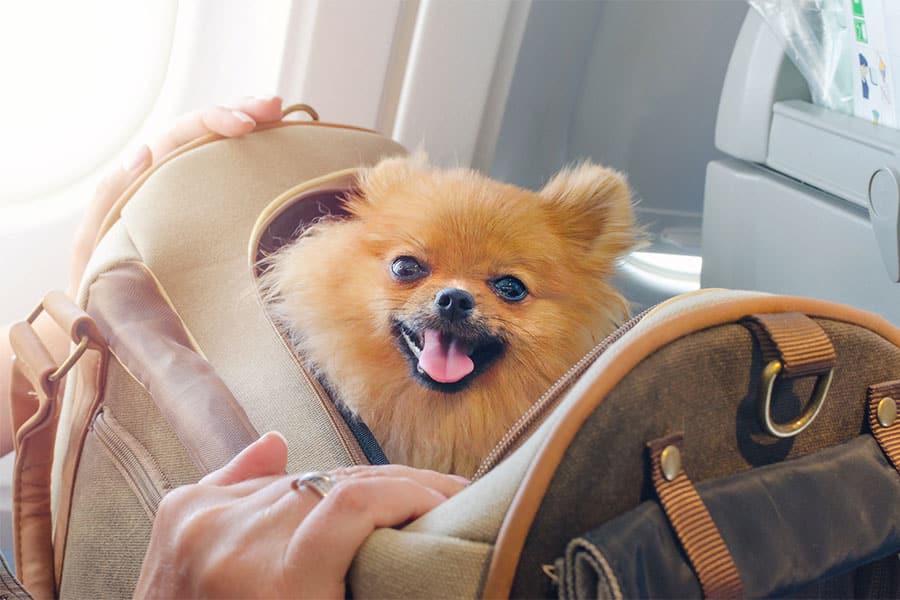Earlier this month, we gave you some tips for flying with your baby. This week, we’ll switch gears and let you in on some tips for flying with your pet. You may be a bit apprehensive facing a flight with your pet, but don’t worry. More than two million pets travel by air each year, according to the USDA.
As with anytime you travel, it’s important to reserve your DTW airport parking well ahead of time to reduce rushing and stress.
Talk to Your Vet
Before you make any plans to fly with your pet, bring them to the vet. Their vet will give them an exam and make sure Fido is in good health to fly. Check with the airline and veterinarian at your destination to ask what documentation you will need. Some airlines require a health certificate that has been issued within 10 days of the flight.
Ask About Restrictions
Airlines are putting more and more restrictions on dog and cat breeds. Those include Brachycephalic, “short-nosed” breeds, such as Boston terriers, bulldogs, and boxers. Some airlines will permit you to fly with your short-nosed pet in the cabin, but they have to fit within the weight and size guidelines. Check with the airline beforehand to avoid unpleasant surprises.
Choose a Pet-Friendly Airline
Not all airlines are the same as far as sensitivity to pet travel. Whereas some airlines won’t fly dogs at all, others will fly them in cargo for a very large fee. Always check with the airline first to see if they prohibit dogs onboard. Many airlines will allow your small dog to fly in-cabin,but don’t assume.
Find the Right Carrier
This is an important step in ensuring a comfortable and safe journey for both your pet and yourself. If you transport your dog in the wrong carrier, you are creating uncomfortable conditions as well as possible life-threatening conditions. Common dimensions for an airline-approved carrier are usually 46 cm X 28 cm X 28 cm.
But each airline has slightly different requirements for pet carriers, so check with them beforehand to learn the exact dimensions for onboard approval. Also, keep in mind that some airlines impose a combined weight allowance for the dog and the carrier, usually at about 20 pounds.
Book Well in Advance
Airlines tend to only allow a limited number of pets on each flight. To prevent getting turned away, be sure to book early so you get your desired flight. Especially when flying in cargo or internationally, it’s critical to make your reservations in advance due to the fact that requirements can take many months to meet and prepare.
Acclimate Your Pet to the Carrier
You can’t just expect to pop your pup in their carrier and take off for the airport, and expect they’ll be fine with it. You need to acclimate them beforehand so the trip isn’t traumatic for them. Purchase a carrier well in advance and get your pet used to it in the weeks before the trip.
It’s just like crate training: your goal will be to make your dog associate the carrier or kennel with a safe, comfortable space. To make sure they develop a positive association, feed your pet in it for many weeks before the flight. You can also place their bed and some favorite toys in it to demonstrate that the carrier is a safe place for playing, sleeping, and relaxing.
Plan Meals and Potty Breaks
You wouldn’t shovel a meal in your mouth and guzzle a bottle of water before boarding a plane, so don’t expect your pet to do that either. Plan out your pet’s meal and potty breaks, and make sure they have eaten and pottied before boarding. This will minimize the chances of an accident on the plane.
Feed your pet at least two hours before going to the airport, giving them enough time to digest the food and relieve themselves. Feeding your pet right before boarding could result in a gassy tummy and an increased chance of accidents.
Arrive at the Airport Extra Early
By extra early, we mean an hour earlier than you normally would by yourself. That means you should arrive four hours early in advance of an international flight, and three hours in advance of a domestic flight. This gives you plenty of time for a potty break for Spot and for checking in at the counter.
Getting there early will also ensure you have extra time in the event of a carrier or paperwork issue. Scrambling at the last minute for a different carrier with acceptable dimensions adds stress to the whole process, and your pet will pick up on that stress.
Have Health Documents Handy
Each airline has its own requirements for pets that fly in cabin and in cargo. Find out in advance which documents your airline requires for each option, and make sure you have them at the ready in case someone requests them. Chances are, you will have to provide them a few times throughout the process, just like you will with your own passport and credentials.
Bring Chew Toys
Pressure builds up in animals’ ears at takeoff and landing just like it does for humans. You’ll know they’re uncomfortable if you see them batting at their ears or shaking their head a lot. To relieve that pressure, give your pet a chew toy or chewy treat.
Reserve Parking Before You Fly With Your Pet
Reserving a spot head of time from home will reduce the stress of parking and heavy traffic. Contact Valet Connections at (734) 992-4946 to reserve today. We wish you the best of luck flying with your pet!


